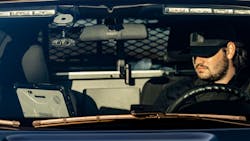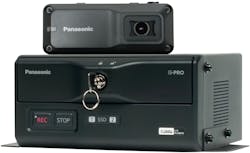Clear View: In-Car Video Systems Continue to Evolve
Patrol vehicles today are equipped with tons of technology that has evolved over the years. In-car video systems are no exception. Video resolution is much higher, making images clear; storage capabilities have vastly increased, and the transmission of data has become easier, taking the burden off of officers; and artificial intelligence is playing a larger role, making the systems an invaluable asset.
We spoke to representatives from Motorola Solutions, Panasonic i-PRO Sensing Solutions Corporation of America and Axon about their new in-car video systems which were introduced 2021.
Motorola Solutions M500
When it was acquired by Motorola Solutions in 2019, WatchGuard already had a well-respected in-car video system called 4RE. It was around that time that the WatchGuard engineering team, along with the Motorola engineering team, joined forces and began working on what is today the M500.
“This product has big shoes to fill in terms of carrying forward a lot of the innovation and the value proposition that was being delivered by the WatchGuard system,” says Andres Lacambra, Senior Director of Mobile Video at Motorola Solutions “You’ll also see some of the traits and characteristics that make the Motorola branded products unique.”
He says that while the engineering teams carried forward a lot of the key elements that made the WatchGuard product a preferred solution, they also began looking at how they could bring in additional levels of value. These included an increased awareness for the officer and added efficiency and safety. “Those three pillars have been key in terms of helping guide the decisions that were made for features and capabilities that are now being delivered on the M500. Every element of the product has been put through that lens,” says Lacambra.Motorola’s experience in artificial intelligence and data analytics also came into play. Lacambra notes that less than 10% of the video recorded by in-car video systems are ever watched and even a smaller percentage are used in court. Agencies make big investments in hardware, software and storage, and only a small percentage of that investment is put to use. Through the use of artificial intelligence, he says that agencies can increase the efficiency of the system as well as have the ability to identify license plates of nearby vehicles.
Another added feature has been the introduction of Automatic License Plate Reader (ALPR) software into the product. “We know ALPR really well and frankly it’s exceeded our own expectations of what we’re able to deliver in terms of viewing angle and rate of detection. It’s not a replacement for a formal, purpose-built in-car mobile ALPR, but for the objective of delivering that extra layer of awareness at a very nominal incremental cost, it’s been great.”
Preorders are being taken now and will be delivered in Q1 of 2022.
i-PRO ICV4000
According to David O’Connor, Director of the Public Safety Division for Panasonic i-PRO Sensing Solutions Corporation of America, the ICV4000 in-car video system boasts higher performance for video capture and processing, superior image quality when paired with the WV-VC35 front camera, open standard MPEG-4 recording format, rigorous device and data security featured, updated Wi-Fi compatibility and connection speeds, and simplified installation with integrated features that previously required external accessories.
O’Connor says the ICV4000 has achieved the lowest total cost of ownership on the market through design and rigorous testing along with intentional forward/backward compatibility and i-PRO’s open-platform strategy.“Today’s compact, high-resolution cameras can provide a 360-degree record of events around the squad car, and body-worn cameras also allow the officer to record close personal interactions from the officer’s point of view. Powerful, secure processing units like the ICV4000 solution provide consistent, tamper-proof capture and storage of video evidence in the field,” says O’Connor. “When combined with sophisticated on-premises or cloud-hosted evidence management systems from Panasonic i-PRO Sensing Solutions of America, officers are freed from the tedious work of managing massive amounts of video for each shift, while providing rapid access to events of interest for review, reporting and investigation.”
Axon Fleet 3
Fleet 3, which began shipping in June, has integrated ALPR technology to provide the officer with alerts for stolen vehicles, arrest warrants, AMBER alerts and other vehicles of interest, according to Blake Bullock, Axon Director of Fleet Products.
Fleet 3 also provides situational awareness powered by Axon Respond for Devices, with live video streaming, alerts, and location updates providing real-time visibility and location mapping of vehicles in the field. In addition, Fleet 3 has better cameras, a brand-new architecture for efficient video offload and an all-new companion application for the PC in the vehicle.
“We are simultaneously addressing industry shortcomings to improve data security, usage transparency and individual privacy, as declining costs enable more widespread use of AI technology,” he says. “We have also worked collaboratively with communities to better understand and implement controls such as maximum retention periods and transparency tools.”
While he says at first there is some skepticism that a 4K dashcam can perform ALPR, especially in dark conditions without infrared, after using the system in the field, the feedback is very positive on the high accuracy and effective plate capture rate.
“We’ve received very positive feedback about the Fleet 3 system,” says Bullock. “Chiefs, Sheriffs, and other agency leaders see the value in having a high performing ALPR system in the entire fleet of patrol cars.” Starting in March 2021, eight domestic and international agencies deployed Axon Fleet 3 as a part of an intensive trial.
“Our agency prides itself on being at the forefront of public safety technology, and with the Fleet 3 ALPR technology, our officers will be able to better serve our community,” says Johns Creek Police Lt. Jon Moses.

Paul Peluso | Editor
Paul Peluso is the Managing Editor of OFFICER Magazine and has been with the Officer Media Group since 2006. He began as an Associate Editor, writing and editing content for Officer.com. Previously, Paul worked as a reporter for several newspapers in the suburbs of Baltimore, MD.





